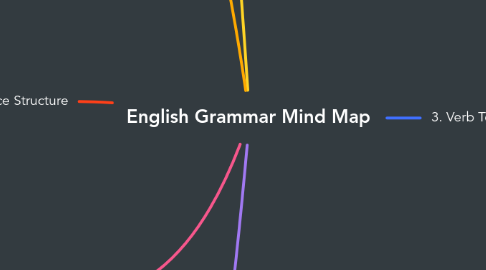
1. 1. Parts of Speech
1.1. Pronoun
1.1.1. Definition: Replaces a noun to avoid repetition. Example: He is going to the store
1.2. Noun
1.2.1. Definition: Names a person, place, thing, or idea. Example: The dog barked loudly.
1.3. Verb
1.3.1. Definition: Describes an action or state of being. Example: She writes beautiful poems.
1.4. Adjective
1.4.1. Definition: Modifies a noun or pronoun. Example: It's a colorful painting.
1.5. Adverb
1.5.1. Definition: Modifies a verb, adjective, or adverb. Example: She speaks quickly.
2. 5.Common Prepositions:
2.1. Above: higher in position than.
2.1.1. Example: The birds are flying above the trees.
2.2. In: inside or within a space.
2.2.1. Example: The cat is in the box.
2.3. On: on top of or in contact with a surface.
2.3.1. Example: The book is on the table.
2.4. Under: beneath or below something.
2.4.1. Example: The dog is under the bed.
2.5. Below: lower in position than.
2.5.1. Example: The fish are swimming below the surface.
2.6. Between: in the space separating two things.
2.6.1. Example: She is sitting between Mary and John.
2.7. Beside: at the side of; next to.
2.7.1. Example: The pen is beside the notebook.
2.8. Behind: at the back of.
2.8.1. Example: The car is parked behind the house.
2.9. In front of: located at the front.
2.9.1. Example: The teacher is standing in front of the class.
2.10. On top of: positioned on the upper surface.
2.10.1. Example: The keys are on top of the shelf.
3. 2. Sentence Structure
3.1. Simple Sentence
3.1.1. Definition: Contains one independent clause. Example: The sun shines.
3.2. Compound Sentence
3.2.1. Definition: Contains two independent clauses joined by a conjunction. Example: She likes coffee, but he prefers tea.
3.3. Complex Sentence
3.3.1. Definition: Contains an independent clause and one or more dependent clauses. Example: Although it rained, they went for a walk.
4. 4. Articles
4.1. a / an Example: I saw an interesting movie yesterday.
4.2. the Example: A cat is in the garden.
5. 6. Conjunctions
5.1. Types of Conjunctions:
5.1.1. Coordinating Conjunctions: Definition: Connect words, phrases, or clauses of equal grammatical rank. Examples: and, but, or, nor, for, so, yet. Usage: He likes coffee and tea. She wants to go, but he prefers to stay.
5.1.2. Subordinating Conjunctions: Definition: Introduce subordinate clauses and establish a relationship between them and the main clause. Examples: although, because, if, since, while, when, after, before. Usage: He left because he was tired. I'll call you when I arrive.
5.1.3. Correlative Conjunctions: Definition: Work in pairs to connect elements of equal grammatical rank. Examples: either...or, neither...nor, both...and, not only...but also. Usage: She is either coming to the party or staying home. Both the cat and the dog are friendly.
5.2. Functions of Conjunctions:
5.2.1. Adding Information (Addition): Example: I like pizza and pasta.
5.2.2. Contrasting Information (Contrast): Example: It's sunny, but it's cold.
5.2.3. Expressing Choices (Alternative): Example: You can have tea or coffee.
5.2.4. Showing Cause and Effect (Causation): Example: She studied hard, so she passed the exam.
5.2.5. Providing Conditions (Condition): Example: If it rains, we will stay indoors.
5.2.6. Expressing Time Relationships (Time): Example: I will call you when I reach home.
5.3. Common Conjunction Errors:
5.3.1. Misusing "And" and "But":
5.3.1.1. Incorrect: She likes coffee, but she likes tea. Correct: She likes coffee and she likes tea.
5.3.2. Comma Splices:
5.3.2.1. Incorrect: I love to read, I often visit the library. Correct: I love to read, and I often visit the library.
